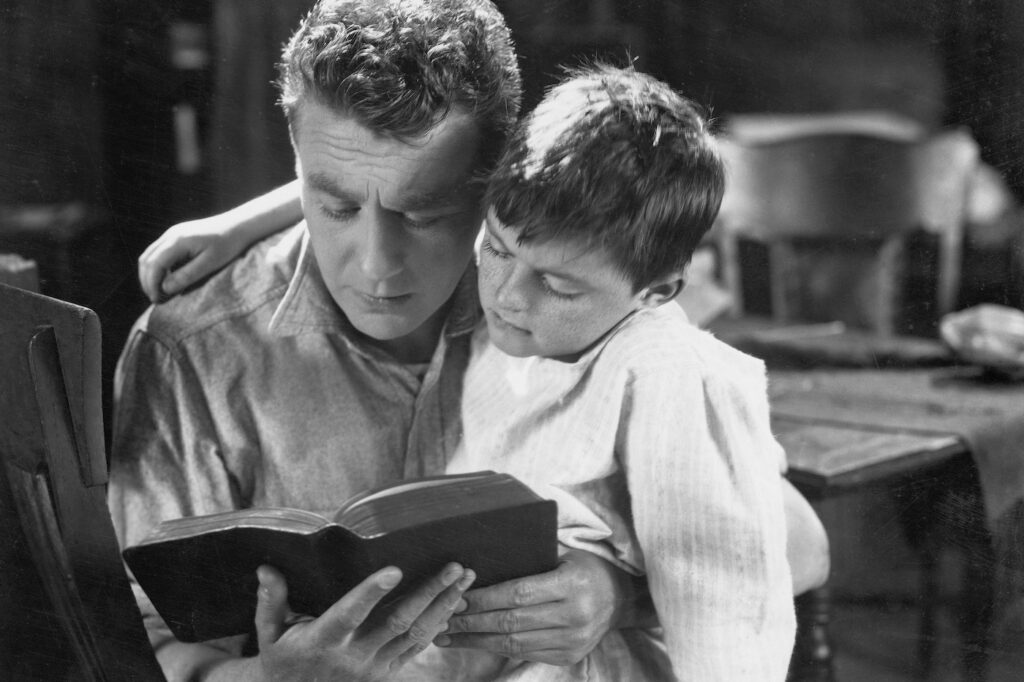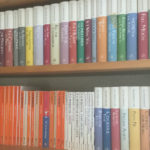My friend Joshua Katz recently published a marvelous essay in The New Criterion, “Word of Mouth,” on the virtues of reading aloud—both as readers and as writers. Language begins with speech, with sounds in the air, not with silent symbols on a printed page or screen. All of us heard and spoke before we read and wrote. Katz quotes a cognitive neuroscientist, Stanislas Dehaene, saying that even as we read silently, we “automatically access speech sounds.” I remember, in high school almost half a century ago, learning some techniques for “speed reading,” but I did not find that high speed was conducive either to reflection on the most important academic texts, or to the enjoyment of literature in my leisure time. Slowing down almost to a speaking pace works much better in both cases. I say almost, for like most people my customary speed is a good bit faster than the spoken word.
Being read to, and then reading aloud ourselves, are how we learn to read in the first place, and the practices of speaking and hearing the written word can continue to be both pleasurable and instructive. When I was in the fifth grade, my teacher, Mrs. Perry, read The Hobbit aloud to our class in its entirety over several weeks. In retrospect, this seems to have been unusually late in my education for this sort of thing, and I don’t know whether a teacher would be permitted to carve out the time for it today. But it was wonderful. It led me to read the Lord of the Rings trilogy on my own a few years later, and it helped to shape my ear for the music of prose.
Being read to, and then reading aloud ourselves, are how we learn to read in the first place, and the practices of speaking and hearing the written word can continue to be both pleasurable and instructive.
In church, we say the prayers of the liturgy in unison with others, and their cadence helps us. The longest of them in the Catholic Mass is the Nicene Creed. If you’ve said it enough, you don’t need to read it in the missal; where one of us might falter in memory, in unison we get through it without a hitch, riding the accustomed rhythm of it. We also hear selections from Scripture, choosing to read along or not, and we can all judge whether a lector, deacon, or priest is reading with understanding and skill. (My wife used to be a lector, and was the only one I have known who regularly had parishioners stop her after Mass to thank her for reading. But she has been an actress, a musician, and a professor of communication specializing in rhetoric—someone, in short, with an ear.)
Start your day with Public Discourse
Sign up and get our daily essays sent straight to your inbox.In the classroom, I have sometimes asked students to read aloud from the texts we are discussing. Other times I have done the reading myself. Taking in the text with ear as well as eye is an aid to understanding. Processing the printed page from eyes to brain to mouth is a challenge to students who are asked to read “archaic” English aloud from Hobbes’s Leviathan or The Federalist. Prose is not poetry, yet it has its own rhythms; and the writer’s meaning—conveyed not in bare words alone but in emphases, inflections, punctuations—can be clarified by speaking and hearing it as well as by seeing it. But reading well aloud takes practice.
Katz notes that the quality of student writing seems to have fallen over the years, and attributes it—rightly, I think—to the fact that “most young people simply don’t read widely or deeply,” as well as to a “de-emphasis on grammar in schools” and a consequent failure to attend to style. As a teacher, he has always advised students to read aloud everything they write, as an aid to revision of anything unclear or ungraceful. That’s good advice, echoing many writers on style.
In The King’s English, first published in 1906, the brothers H. W. and F. G. Fowler advised: “A writer who cannot trust himself to balance his sentences properly should read aloud all that he writes. It is useless for him to argue that readers will not read his works aloud, and that therefore the fault of which we are speaking will escape notice. For although the fault may appear to be exclusively one of sound, it is always in fact a fault of sense.” Twenty years later, H. W. Fowler would publish the first edition of A Dictionary of Modern English Usage, where he remarked in his entry on “Rhythm”: “By the time the reader aloud has discovered that in a really good writer every sentence is rhythmical, while bad writers perpetually offend or puzzle his ear—a discovery, it is true, not very quickly made—, he is capable of passing judgement on each of his own sentences if he will be at the pains to read them, too, aloud.” Fowler did not insist on this literally: “there is an art of tacit reading aloud … reading with the eye & not the mouth, that is, but being as fully aware of the unuttered sound as of the sense.”
And there’s more from other mavens of English prose. Robert Graves and Alan Hodge, in their 1943 book The Reader Over Your Shoulder, say that we should write “in the first place for silent reading, but with consideration for euphony if read aloud.” The judicious combination of meaning and euphony was so important that they enunciated twenty-five “principles of clear statement” and sixteen “graces of prose,” and then applied these forty-one standards to the correction of unclear and graceless passages from the works of authors living at the time, such as Eliot, Hemingway, Huxley, Keynes, Pound, Russell, and Shaw. If their victims took the chastisement with forbearance, good for them, because Graves and Hodge did home in on some howlers.
Wilson Follett, in Modern American Usage, had this to say on the relation of the eye to the ear when reading:
No doubt, most of the prose that finds its way into print is read aloud by very few persons; some of it is perhaps never so read by anyone. Nonetheless, prose that cannot be read aloud with pleasure is probably bad prose. Euphony is not the highest virtue of prose, but one of its rudimentary requirements. The reason is the simple one that persons not tone-deaf, when they read silently, hear with the inner ear and are quite as much disturbed by clashing sounds as if they were reading aloud or listening. This effect is independent of the tempo at which their silent reading is done.
Finally, there’s Benjamin Dreyer, in his recent bestselling guide, Dreyer’s English: “One of the best ways to determine whether your prose is well-constructed is to read it aloud. A sentence that can’t be readily voiced is a sentence that likely needs to be rewritten.” Quite right. And, having read this passage aloud, I would substitute “probably” for “likely.” It sounds better, and “likely” is happier being an adjective than an adverb.
In fiction and nonfiction alike, what keeps prose lively without exhausting the reader is plain meaning conveyed with a quiet grace.
All this business about euphony and rhythm may make one think of poetry, which (classically at least) has formal expectations of meter and often of rhyme. As Fowler pointed out, “rhyme” and “rhythm” began life as the same word, from the Greek rhuthmos. But Fowler also condemned what he called “metrical prose,” and Follett cautioned against “fortuitous rhyme.” There is a kind of prose in what Graves and Hodge call “the grand style,” featuring “ingenious or graceful feats with language” that orators may use to good effect. Think of the figures, metaphors, and cadences of Lincoln’s Gettysburg Address, which approaches poetry without losing contact with prosaic plainness of meaning. Or of the peroration of Churchill’s “Finest Hour” speech in the House of Commons in June 1940. These are grand, each in the style of the statesman’s country.
But rhetorical grandeur is too rich a diet for everyday reading. In fiction and nonfiction alike, what keeps prose lively without exhausting the reader is plain meaning conveyed with a quiet grace. If what we write, when read aloud, is free of solecisms and confusions of meaning, and flows naturally as though an intelligent speaker were addressing us, we have met the minimum requirements of prose style. If it then has some grace notes while yet being free of any pretensions to poetic or rhetorical flight, then we have added to the reader’s pleasure without overtaxing his tolerance. On one hand, deficiencies are avoided; on the other, excesses.
Graves and Hodge remark that a poet “assumes his reader to have perfect leisure and patience for dwelling on each word in a poem and appreciating its relation with every other.” (Graves was himself a highly regarded poet.) But there are “two main objects in ordinary prose writing: to convey a message, and to include in it nothing that will distract the reader’s attention or check his habitual pace of reading—he should feel that he is seated at ease in a taxi, not riding a temperamental horse through traffic.”
Two months ago, I wrote in this space about the depredations on literature undertaken by publishers that employ “sensitivity readers” to render authors such as Roald Dahl and Ian Fleming more “inclusive” and less offensive to some contemporary readers. Since then I’ve learned that a similar effort is under way with the republishing of the Jeeves stories of P. G. Wodehouse (about whom I wrote here almost three years ago). No author of the twentieth century took more care than Wodehouse to write precisely what he meant to say. The magic he achieves is to put the reader completely at ease in that taxi and bubbling with laughter around every corner—especially if reading the stories aloud. It is inconceivable that any one of the persons “updating” his works for postmodern sensibilities can lay a finger on his prose without damaging it. If they would but read Wodehouse aloud to one another—assuming they have both ears and brains—they would give up the project of “improving” him faster than Jeeves can get Bertie Wooster out of the soup.














